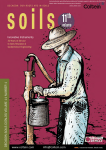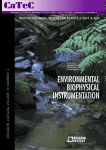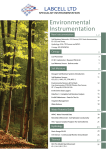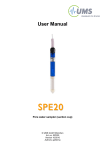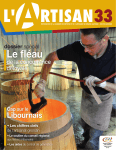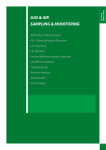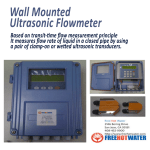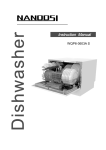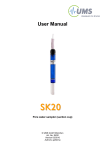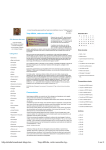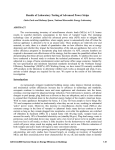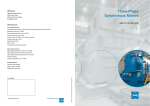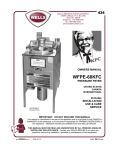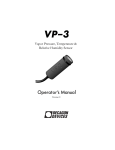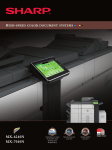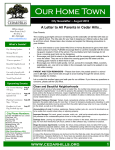Download NEW FOR PDF
Transcript
Turfschipper 114 | 2292 JB Wateringen | Tel. 0174 272330 | Fax. 0174 272340 | [email protected] | www.catec.nl INSIDE NEW PRODUCTS FOR 2010–2011 RESEARCH BRIEFS CURRENT SOIL, PLANT, AND WATER RESEARCH FROM AROUND THE WORLD DECAGON EDUCATIONAL INITIATIVES AND RESEARCH GRANTS D 1 G. A. Harris Fellowship X Instrumenting canopy soil over 19 m off the ground. Camila Tejo Haristoy is one of six 2010 winners of the G.A. Harris Fellowship. The fellowship provides $30,000 worth of instruments to graduate students in environmental and geotechnical fields. This year’s competition focused on innovative soil and plant monitoring. Haristoy is studying canopy soil in Pacific Northwest Sitka Spruce. 2 For more information about the G.A. Harris Fellowship, visit decagon.com and choose “G.A.Harris Fellowship” on the “About Us” page (decagon.com/about-us/ga-harris-fellowship). TABLE OF CONTENTS Research Briefs CANOPY Leaf Porometer LP-80 Leaf Wetness Sensor Page 4 Page 6 Page 8 SOIL MOISTURE Complete Soil Moisture Analysis Software and Data Collection Soil Moisture Sensors Leaf Wetness Sensor— Quantifies the amount of fog available for use by the living fossil Welwitschia Mirabilis. Page 9 Page 10 Page 11 Page 12 EM50 SERIES LOGGERS Em50 Loggers Em50G Remote Logger Em50R Radio Logger Multi-site Accessories Watershed Characterization Irrigation Monitoring Page Page Page Page 14 16 18 19 Page 22 Page 24 WATER POTENTIAL WP4C Tensiometers Hyprop AquaSorp IG MPS1 Case Study: Complex Hydrology—Can it be hassle free? Page 20 & 21 Page Page Page Page Page 26 28 30 31 32 Page Page Page Page 34 36 38 40 HYDROLOGY Infiltrometer Monitor Solute Movement Drain Gauge G2-G3 Pore Water Samplers THERMAL Sample Disturbance —A problem when measuring water potential? Page 29 KD2Pro Page 42 Essential Soil References Page 44 Distributors Page 46 D 3 Porometer Research for Everyone GET HIGH QUALITY DATA WITHOUT FANS, TUBES, OR PUMPS. B steady state technology (see details at right) makes accurate stomatal conductance measurements affordable and practical for everyday research. Detail water use, indicate water stress and compare physiological varieties. Add stomatal conductance data to any canopy study with this elegantly designed Leaf Porometer. REAKTHROUGH Applications Water Stress Measurements Variety Testing & Comparison Fundamental Research on Stomatal Function Teaching and Student Labs Benefits Automatic sampling mode eliminates user subjectivity. Accurate Steady-State measurement. No tubes, pumps, or fans. Leaf Porometer Specifications Conductance range 0 to 1000 mmol m -2 s -1 Accuracy ± 10% Operating Environment 5 to 40ºC, 10 to 90% RH, non-condensing Units mmol m -2 s -1, m 2s mol -1, s/m Measurement diameter 6.3 mm Sensor head cable length 1.2 m (4 ft.) Measurement time in Auto mode 30 s See the extended specifications for the leaf porometer at www.decagon.com 4 Watch a 3 minute video introducing the Porometer at www.decagon.com/education/ video-index/ D MATHEMATICS OF THE STEADY STATE POROMETER RVS CANOPY CVL ecagon’s Steady State porometer measures stomatal conductance using a sensor head with a fixed diffusion path to the leaf. It measures the vapor concentration at two different locations in the diffusion path. It computes vapor flux from the vapor concentration measurements and the known conductance of the diffusion path using the following equation: Leaf = R1 CV1 R2 Humidity Sensors CV2 Schematic illustrating how the porometer measures stomatal conductance. Where CvL is the vapor concentration at the leaf, Cv1 and Cv2 are the concentrations at the two sensor locations, Rs is the stomatal resistance, Rv1 is the resistance between the leaf and the first sensor, and R2 is the resistance between the two sensors. If the temperatures of the two sensors are the same, vapor concentration can be replaced with relative humidity, giving 1 Conductance is the reciprocal of resistance, so Cvs = 1/Rvs. D 5 Canopy Measurements PAR / LAI Photosynthetically Active Radiation & Leaf Area Index MEASURE BOTH PAR AND LAI WITH ONE LIGHTWEIGHT, STREAMLINED WAND U to estimate biomass production without destroying the crop (see details at right). Measure photosynthetically active radiation (PAR) and get leaf area index (LAI) values simultaneously in real time. Store approximately 9000 data points manually by pressing a button or automatically in unattended sampling mode. SE PAR DATA INCLUDED ACCESSORIES EXTERNAL PAR SENSOR 2 meter cable with connector for direct connection to the ceptometer’s external port. Calibrated to provide an output of about 0.1 mV per µmol m -2 s -1 (calibration label provided). RS-232 CABLE— for interfacing between your computer and the AccuPAR. CARRYING CASE Polyethylene hardened case with custom foam cutouts allow the instrument and its accessories to be safely stored inside. 3.6 kg, 11.8 x 24 x 109 cm. Watch a 5 minute video on measuring PAR and LAI with the AccuPAR LP-80 at www.decagon.com/education/ video-index/ 6 AccuPAR LP-80 SPECIFICATIONS Operating environment 0° to 50°C (32°-122°F), 0 to 100% relative humidity Probe length 86.5 cm Number of sensors 80 Overall length 102 cm (40.25 in) Microcontroller dimensions 15.8 x 9.5 x 3.3 cm (6.2 x 3.75 x 1.3 in) PAR range 0 to >2,500 µmol m -2s -1 Resolution 1 µmol m -2s -1 Minimum spatial resolution 1 cm Data storage capacity 1MB RAM, 9000 readings Unattended logging interval User selectable, between 1 and 60 minutes Instrument weight 1.22 kg (2.7 lbs) Data retrieval Direct via RS-232 cable Power 4, AA Alkaline cells External PAR sensor connector Locking 3-pin circular connector (2 m cable) Extension cable option 7.6 m (25 ft) NONDESTRUCTIVE BIOMASS PREDICTION CANOPY T he detailed processes in photosynthesis are complicated and hard to model. In many cases, however, it’s possible to simplify the model by focusing on one or more of the limitations to assimilation. To learn more about the relationship between light interception and biomass production, visit www.decagon.com/ canopynews2009 Limited by Light, Limited by Water: Two Separate Approaches We could postulate situations where light would be the limiting factor in assimilation, and others where water would be the limiting factor. Our models, in words, might be: assimilation is proportional to the plant’s ability to capture light, or assimilation is proportional to the plant’s ability to capture water. Both approaches can be useful in modeling biomass production. Knowing Which Model to Use The most efficient way to determine whether light or water is the limiting factor is to simply run both mathematical models daily to see which one predicts the lowest value. That value is the best predictor of dry matter production for the particular day on which it is run. The 2009 Decagon Canopy News feature article, Simple Models for Carbon Assimilation by Plants, describes the math involved and climatic data needed to run these two alternative predictors of dry matter accumulation and shows how to use them together to give the most accurate result. D 7 Ready-to-Use Leaf Wetness Sensor DETECT LEAF WETNESS DURATION WITH A SENSITIVE, CALIBRATED, STANDARDIZED SENSOR M affect plants only when moisture is present on the leaf surface. The Dielectric Leaf Wetness Sensor determines the presence and duration of wetness on a leaf’s surface, enabling researchers and growers to forecast disease and protect plant canopies. The Leaf Wetness Sensor approximates the thermal mass and radiative properties of leaves to closely mimic the wetness state of a real leaf. Because the sensor does not take resistancebased measurements, it requires no painting or user calibration, and it can detect ice formation as well. ANY DISEASES Leaf Wetness Sensor Specifications Measurement time 10 ms Power 2.5 VDC @ 10 mA to 5 VDC @ 7 mA Output 250 to 1500 mV Operating Environment -20 to 60°C Expected Lifetime 2+ years continuous use Probe Dimensions 11.2 x 5.8 x 0.075 cm (4.4 x 2.3 x 0.029 in) Cable Length 5 m standard, extension cables available Connector type 3.5 mm plug Datalogger Compatibility (not exclusive) Decagon Em50, Em50R, Em50G Campbell Scientific CR10, 10X, 21X, 23X, 1000, 3000, 5000 Applications Disease forecasting and modeling Ecological and Agricultural Research 8 recipitation is usually assumed to be the primary input in a water balance. The Namib desert is hyper-arid in terms of rainfall, but experiences frequent coastal fog events, an environment that falls outside the realm of standard water balance model assumptions. The fog has been suggested to provide sufficient water to many of the endemic Namib plants up to approximately 60 kilometers inland. Quantifying fog contributions to the water balance is difficult. Keir Soderberg, second place winner of the 2009 G.A. Harris Research Instruments Fellowship. Welwitschia mirabilis, which has a lifespan of 400 to 1500 years, uses water from fog in order to survive. See all the winners of the 2009 G.A. Harris Research Instruments Fellowship and download the 2010 application at www.decagon.com/about-us/ CANOPY P QUANTIFY UNKNOWNS IN A WATER BALANCE Leaf Wetness Sensor Quantifies Fog Kier Soderberg, a PhD candidate at the University of Virginia, coupled the leaf wetness sensor with other environmental parameters to help quantify the amount of fog that the Namib plants such as Welwitschia mirabilis are able to utilize. Measure Other Unusual Variables Do you have variables in your water balance that you are struggling to quantify? Innovative research sometimes requires innovative sensor solutions. Contact Decagon’s application support specialists to help brainstorm ideas for your specific project. D 9 Complete Soil Moisture Analysis Tools to measure, collect, and analyze your data. Data Management Soil Moisture and Environmental Sensors ECH2O soil moisture DataTrac 3 is a completely redesigned software package sensors deliver: that helps you view and effectively manage your data. Research Grade Accuracy— ±3 VWC in typical soils, can be DataTrac 3 does the heavy calibrated for improved lifting—pulling the logger data, amending files, tracking performance. nodes, graphing sets—so you can see what’s going on with Reliable Data—patented technology eliminates your study at any point without interrupting the data interference from salinity and texture differences. stream. Check in daily or weekly to add notes and Practicality—low power, make observations. low-cost sensors allow you to characterize spatial variability more completely. Complete the system with environmental sensors for context to show why soil water content is changing. Data Acquisition Systems The Em50 series of loggers make data collection easy, whether you’re installing a single station or a large, multi-station site. All Em50 loggers are: Pre-programmed—plug the sensors in and start logging. No user programming required. Weatherproof—no extra enclosure needed. Internally powered—runs 6 months-2 years on enclosed AA batteries. No external power needed. 10 Wireless options let you collect data from almost anywhere. Z DataTrac 3—SOFTWARE DataTrac 3 graphical and database software organizes, graphs, and stores data from Em50 series or Em5b data loggers. Users can view and edit data in table format, create reports, and transfer data to other DataTrac 3 users. Minimum System Requirements Microsoft Windows XP or newer Monitor set to display 1024 x 768 pixels (minimum) DataTrac 3 ORGANIZE AND ANALYZE YOUR SOIL MOISTURE DATA I magine having an assistant that brings you data, general trends, and specific problems from all of your research sites at the start of every day. DataTrac 3 is that assistant—a completely redesigned software package that lets you view and manage your data. Contact Decagon for a free 30 day trial. When DataTrac 3 is started, all of your most recent data downloads will be updated and graphed allowing you to see changes in real time. Instead of looking back at the data and wondering what happened, you can add event-related comments. Just a few new features: Logger tree let you organize your data logger nodes during set-up. Annotate your notes on current thinking or relevant environmental conditions. Growing Tools let you create meaningful metrics such as vapor pressure deficit and growing degree days. D 11 Research-Grade Soil Moisture Sensors All sensor electrical interface: 3.5 mm plug or 3-wire. MODEL L E N GT H MEASUREMENT RANGE ACCURACY BENEFITS ± 3% VWC, typical mineral soils up to 8 dS/m Rockwool ± 3% VWC, 0.5 to 8 dS/m EC-5 5 cm Volumetric water content 0–100% VWC Lowest cost for large sensor networks. Potting Soil ± 3% VWC, 3 to 14 dS/m (ea): ± 0.5 from ea of 2 to 10 ± 2.5 from ea of 10 to 50 ± 3% VWC, typical mineral soils up to 8 dS/m 10HS 10 cm Dielectric permittivity, Volumetric water content Apparent dielectric permittivity ( e a ): 1 (air) to 50, 0–57% VWC Apparent dielectric permittivity ( e a ): 1 (air) to 80, 0–100% VWC Temperature -40 to 50 ºC 5TM 5TE 5 cm 5 cm (ea): ± 1 ea (unitless) from 1–40 (soil range) ± 15% from 40–80 ± 3% VWC, typical mineral soils up to 8 dS/m Temperature ± 1 ºC Volumetric water content, Temperature, Electrical conductivity, Dielectric Permittivity Apparent dielectric permittivity ( e a ): 1 (air) to 80, 0–100% VWC Temperature -40 to 50 ºC EC 0 to 23 dS/m (bulk) (ea): ± 1 ea (unitless) from 1–40 (soil range) ± 15% from 40–80 ± 3% VWC, typical mineral soils up to 8 dS/m 12 Soil matric potential Manage salts and fertilizers in your system. Bulk EC ± 10% Temperature ± 1 ºC ± 20% of reading from -50 to -500 kPa 5 cm Include temperature dependencies in your study. Volumetric water content, Temperature, Dielectric Permittivity ± 40% of reading from -10 to -50 kPa MPS-1 Largest volume of influence decreases effects of heterogeneity. -10 to -500 kPa Maintenance-free water potential measurements that do not drift over time. Above Ground Sensors The Decagon system also allows you to characterize the environment above the soil surface. The sensors below can be used with the Em50 series data loggers and software to provide data on a variety of environmental variables. TEMP/RH Durable sensor measures relative humidity and temperature and outputs both values as a digital signal. Probe RH Range 0 to 100% RH RH Accuracy ±2% from 10–90% RH ±3% from 0–10% RH and 90–100% RH Temperature Range -40 to 60 ° C The Leaf Wetness Sensor measures duration of leaf wetness and requires no painting or calibration and detects trace amounts of water or ice on the sensor sur face. Operating Environment -20 to 60° C The Pyranometer Model PYR and the PAR Photon Flux Sensor are completely water proof, submersible and designed for continuous outdoor use. A leveling plate is included. The ECRN-100 Precipitation Sensor is best for research applications and measuring rainfall. Resolution 0.2 mm Dimensions 17 cm x 14.2 cm Cable length 1m Range 0 to 2000 µ mol / m 2 s (PAR) Range 0 to 1750 W m -2 (PYR) Dimensions 24mm diameter, 29 mm deep. Accuracy ±5% The ECRN-50 Precipitation Sensor is best for measuring irrigation events. Resolution 1 mm Dimensions 5 cm x 10 cm SOIL TEMPERATURE SENSOR model ECT Range -40 to 60° C Accuracy ±0.25° C Cup Anemometer The anemometer measures both wind speed (using windcups and a magnetic switch) and wind direction (with windvane and potentiometer). Includes sealed stainlesssteelbearings for long life. The range and accuracy specifications of this unit have been verified in windtunnel tests (information available upon request). For use only with our Em50 or Em50R Data logger using ECH2O Utility. Watch a 5 minute video showing the factory calibration process at www.decagon.com/education/ video-index/ D 13 Spend more time with your data… T he Em50 series of data loggers are designed for researchers who just want quality data. You install the sensors, plug them into the logger, set the clock and measurement intervals, and start logging data. The Em50’s primary advantage is simply this: NO PROGRAMMING. MEASUREMENT NODES—Em50 Logger Channels 5. Storage >36,000 scans - Each scan includes logger name, date, time, and 5 measurements. Scan Interval User-programmable from 1/minute to 1/day. (minimum Em50G scan interval every 5 minutes). Communication Serial RS232, USB, radio, cellular. Power 5, AA alkaline batteries. Dimensions 12.7 x 20.3 x 5.1 cm (5 x 8 x 2 in) Enclosure Rating IP55, NEMA3. Download software included with Em50 purchase. CONTINUOUS MONITORING [ Em50 is a highly weather resistant logger for all Decagon sensors. We recommend and support use of Campbell Scientific loggers with our sensors for applications requiring programming and/or control. 14 not your data logger. The ECH2O System NO PROGRAMMING Em50 Series Logger Options 1 Basic Data Logging The standard Em50 data logger is the least expensive and has the longest battery life of all the Em50 series loggers. It requires a direct connection to a laptop or other computing device to download data. The Em50 option is best if: You don’t need to access your data on a regular basis. Your site is so remote that you need the data logger batteries to last for over two years. 2 Long Distance Data Delivery The Em50G remote data logger uses the cellular network to upload your data from the field to the internet. You can access the data at any time from any location that has an internet connection. The cellular modem is fully integrated with the logger making setup a snap. The logger comes ready to go right out of the box with a one-year pre-paid SIM card and subscription to the Decagon Data Service. Just plug in your sensors, set your measurement interval, and you’re done. Your data will be waiting for you back at the office. The Em50G is the best option if: 3 Local Data Connection The Em50R wireless data logger uses long range 900 MHz* radio communication to send your data to a central data receiving location. No existing wireless infrastructure is necessary. The Em50R collects data at a single location and delivers data over short distances (2 to 5 miles). The Em50R is the best option if: You don’t have cell coverage at your field site. You want to collect data from all your loggers at a central location. *2.4 GHz radios available for global customers. Your research sites have cell service. You want regular access to your data but can’t visit your site to get it. D 15 Your Data, Delivered Get your data in seconds on any computer with an internet connection. Y ou don’t need a mobile phone, a solar panel, nor even a conversation with your local cell service provider to make this work. Measure, log, and remotely transmit data from five Decagon sensors at up to 5 minute intervals. You pick the times during the day when Em50G logger data is automatically sent to the Decagon Data Service via the integrated cellular module. Once uploaded, you have 24/7 access over the internet to your data stored on the Decagon Data Service. No logger programming or expert knowledge of cellular networks are necessary. Automatically download data to DataTrac or create Excel files on demand. Share your data or not. Sharing you data with trusted colleagues is as easy as sharing your subscription information. 16 No-hassle cellular service included in the the box. First year service is pre-paid. Em50G can be used in 120 countries with more than 200 partner networks providing GSM/GPRS cellular services. Decagon Data Service (included with every Em50G) provides 24/7 access to data from anywhere you have cellular service. Data is confidential, encrypted, and password protected. Downloads from the Decagon Data Service are encrypted using the same security a your online bank account. Em50G provides go/no go cellular signal testing. Full cellular and data transfer testing available with included software. Em50G powers the sensors and the integrated cellular module on 5 AA batteries; no external power source needed. Em50G Specifications Input ports 5, 12-bit analog or 32-bit digital, compatible with any Decagon Devices sensor. Enclosure access Hinged door with eyelet for securing with usersupplied padlock. Data storage 1MB (36,800 scans on all 5 ports). Mounting 3.8 cm (1.5 inch) mast or wall mount Memory type Non-volatile Flash Local communication Dedicated serial port 3.5mm stereo jack for use with the Decagon Serial Cable Adapter (SCA) or Decagon USB Cable Adaptor (UCA) Logging interval 5 minutes to 24 hours, logged data is 1-minute average of user-specified interval. Upload interval 1 to 6 times per day at user-specified times. Operating environment -30°C to 60°C, up to 100% RH Battery service life 6+ months Decagon Data Service (included with every Em50G) Data plan Annual subscription provided by Decagon Devices with over 200 GSM/GPRS partner networks in 120 countries. Server location Decagon Network Operations Center, Pullman WA USA External power None needed Enclosure Weatherproof, impact and UV-resistant polymer. Enclosure dimensions 12.7 x 20.3 x 5.1 cm (5 x 8 x 2 in) Data security SSL/TLS encrypted data transfer; a unique Device ID and password (provided with each logger) are necessary for accessing data from the server. Cellular Frequency Quad-band (850/900/1800/ 1900 MHz) GSM/GPRS for use worldwide. Software ECHO Utility Software and DataTrac Software Demo 17 Transmit Data Locally COLLECT DATA WIRELESSLY AT A SINGLE POINT X Multiple Em50R loggers collect data then transmit to a nearby office (2 to 5 mile range). T he Em50R wireless data logger transmits data to a central receiving location using 900 MHz* radio communication. No existing wireless infrastructure is necessary. Multiple Em50R loggers are often used to collect data from many locations, which are then transmitted to a nearby office (2 to 5 mile range) Benefits Long-range wireless radio allows large spatial monitoring. No need to visit each site after initial installation. No programming—only simple configuration. Em50R Logger—MEASUREMENT NODES Channels 5. Storage >36,000 scans - Each scan includes logger name, date, time, and 5 measurements Scan Interval User-programmable from 1/minute to 1/day Communication 900 MHz radio* Power 5, AA alkaline batteries Battery service life 6+ months Dimensions 12.7 x 20.3 x 5.1 cm (5 x 8 x 2 in) *2.4 GHz radios available for global customers. [ DataStation—BASE STATION The DataStation radio base station collects and stores data from multiple Em50R data loggers. 18.4cm L x 10.5cm W x 2.86cm H (7.25”L x 4.125”W x 1.125”H) 18 “Confirm Data Delivery” protocol allows complete and reliable data transfer. RS232 serial cable connectivity. Storage for over 28,000 broadcast packets. Flexible 12–24 V AC/DC power. Telemetry testing for connection quality analysis during set-up. Enclosures and solar panels for remote installs. Accessories for multi-site installation. Save your laptop by investing in an Archer Field PC. Laptops are great, but they require two hands and aren’t built to be submersed, dropped, and driven around on dusty roads. Archer is built for frequent field trips, and it will last long after it has become worth the Em5b Logger For EC-5, EC-10, EC-20, ECRN-50, ECT, & 10HS Storage 3,300 scans, 1/minute to 1/day Communication RS232 Power 4, AAA alkaline batteries, battery life 3+ yrs Dimensions 8.7 x 6.2 x 3.5 cm (3.75 x 2.75 x 1.25 in) Download software included with Em5b purchase. X The Em5b has 5 channels that allow scientists on a tight budget to monitor soil moisture and other environmental parameters investment. Archer Field PC The ultra-rugged Archer Field PC is our recommended platform for managing data in-the-field. The Archer is water-proof, shock-resisitant, and remarkably versatile. The Archer is capable of a wide range of adaptations, including: Capture, map, or navigate using GPS options. Communicate wirelessly via Bluetooth, Wi-Fi. See your screen in the sun. 10+ hour battery life. Windows Mobile 6.1 operating system. Comes with ECH 2O Utility Mobile. k The ProCheck instantaneously displays calibrated or raw readings of any Decagon soil moisture or environmental sensor. Use the instant-read ProCheck to test individual sensors for good installation. ProCheck For all Decagon sensors. Channels 1 Storage 5,000 readings. Each reading includes sensor type, date, time, raw value, calibrated value and calibration coefficients. Communication Serial RS232. Power 4, AA alkaline batteries Dimensions 15.5 x 9.5 x 3.5 cm (6 x 3.7 x 1.4 in) ECH2O Utility software Free software included with every Em50 Series and Em5b data logger. Configure sensors, change measurement intervals, monitor battery life and memory levels. CAPABILITIES Instantaneously read and store data from any Decagon sensor. Troubleshoot field measurements. Address sensors being used in SDI-12 mode. D 19 CASE STUDY: COMPLEX HYDROLOGY ON THE PALOUSE A t Cook Farm, Decagon scientists and Washington State University researchers are calibrating, refining and testing an existing hydrologic model for the Palouse. X SOIL MOISTURE SYSTEM WITH TEMPERATURE / EC OPTION Each node has 5 soil moisture sensors monitoring the soil profile at one foot vertical intervals—the shallowest is a foot below the surface; the deepest five feet down. The sensors measure volumetric water content, soil temperature, and Electrical Conductivity. The Em50R logger stores the data internally and transmits it to the DataStation. “We have soil moisture sensors See sensors specifications on page 12. buried at the same depths all over the farm, but the volumetric water content readings can be different from location to location. Sometimes they seem almost random. When I flew over the farm this summer, suddenly I could see those variations in living color. Patterns of wheat senescence showed exactly what the sensors had been telling us—golden wheat in the dry areas, greener wheat in the valleys and every variation in between.” Watch a 5 minute video of a Soil Moisture System installation at www.decagon.com/education/ video-index/ 20 42 200+ wireless logger nodes soil moisture sensors CASE STUDY “Hassle Free” Telemetry X DATASTATION INTEGRATED WITH AN EXISTING METEOROLOGICAL TOWER The station gathers soil moisture, temperature, and EC data from all 42 loggers hourly. See DataStation specifications on page 18. YOU CAN SEE SIGNAL STRENGTH AND CONNECTION SPEED IN REAL-TIME AS YOU PICK THE BEST SPOT FOR A DATA LOGGER NODE SITE. IT’S SIMPLE. TEST FIRST AND INSTALL SECOND. D 21 Watershed Characterization Package The elements of this bundle were chosen to help you nail two tough components of the water balance: storage and deep percolation. The drain gauge’s elegant design ensures that water will flow through and not around it, giving you accurate deep percolation rate. High accuracy water content sensors let you calculate storage from differences in profile water content. Close Your Water Balance WITH PRECIPITATION, SOIL STORAGE, AND DEEP DRAINAGE n Get closer to completing the water balance. n Collect the data you need to calculate water input, storage, and drainage in the vadose zone. n Measure deep drainage rather than estimating to reduce errors in water balance calculation IN THE BOX Standard Configuration #40525 Water Balance System Drain Gauge G3 Adding on a rain gauge gives you the downward “vertical water profile”—incoming, storage, and drainage. Three, 5TM Soil Moisture Sensors ECRN-100 High Resolution Rain Gauge Em50 Data Logger DataTrac 3 Software USB Cable Batteries Mounting hardware Printed and electronic documentation 22 Contact Decagon to add telemetry options. WATER BALANCE Three, 5TM Soil Moisture Sensors Measure water storage using dielectric water content sensors at different depths in the profile. Sensors specs on page 12. Drain Gauge G3 Measure deep drainage with this thoughtfully designed passive capillary lysimeter. Drain Gauge G3 specs on page 37. DataTrac 3 Software Dynamic graphical interface brings data to life. Organize, graph, and store data; view and edit data in table format; create reports and transfer data to other DataTrac 3 users. ECRN-100 High Resolution Rain Gauge Measure incoming water values for water balance calculations. Em50 Data Logger Plug in the sensors, set time and measurement intervals, and start logging data. No programming necessary. D 23 Irrigation Monitoring Package The elements of this bundle were chosen specifically for you to see both how much water is in the soil and how much of that water is available to plants. A matric potential sensor measures plant available water so you know when to turn irrigation on. n Know when to turn irrigation on. Soil moisture sensors only measure volumetric water content. Use the matric potential sensor to monitor plant available water. n Know when to turn irrigation off. Fast-response soil moisture sensors let you track plant water use in real time and set an accurate full point that minimizes wasted water. IN THE BOX Soil moisture sensors let you know when you’ve reached field capacity and should turn irrigation off. Standard Configuration #40523 Soil Moisture/Irrigation System Two, 5TE Soil Moisture Sensors MPS-1 Matric Potential Sensor Pressure on/off switch ECRN-100 Precipitation Sensor Em50 Data Logger DataTrac 3 Software A pressure switch monitors pipes to make sure irrigation is happening as scheduled. USB Cable Batteries Mounting hardware Printed and electronic documentation Contact Decagon to add telemetry options. DataTrac lets you watch the interaction of all the sensors graphically. 24 See sensor specs on pages 12 and 13. IRRIGATION Settling For 1 Water Parameter? KNOW WHEN TO TURN IT ON AND WHEN TO TURN IT OFF Pressure On/Off Switch Tracks irrigation events by recording when water is turned on and off. MPS-1 Matric Potential Sensor This sensor goes beyond just water content to describe water availability. Measures 0 to -500 kPa. DataTrac 3 Software Dynamic graphical interface brings data to life. Organize, graph, and store data; view data in table format; create reports and transfer data to other DataTrac 3 users. ECRN-100 Precipitation Sensor Designed to measure both precipitation and irrigation events. Two, 5TE Moisture Sensors Soil moisture sensors located within and below the root zone track water content through the profile. Em50 Data Logger Plug in the sensors, set time and measurement intervals, and start logging data. No programming necessary. D 25 Essential Water Potential Data 26 MAKE FAST, ACCURATE WATER POTENTIAL MEASUREMENTS IN THE LAB NEW FEATURES Precise Mode—verifies full equilibrium before displaying a final reading. M easure the water potential of soil, soilless substrate, plant tissue, or any porous material in 5 to 10 minutes. Effective range: -0.1 to -300 MPa.* Speedy Equilibration—new hydrophobic teflon impregnated nickel alloy sample chamber coating reduces equilibration time. Finely-Tuned Adjustments—new algorithms allow precision calibration and ± 0.05 MPa (or better) accuracy. Better range and accuracy—resolves temperatures to a thousandth of a degree to push the functional range to -0.1 MPa. *Note: WP4C will read to 0 MPa, but readings of samples wetter than -0.1 MPa will have an increasing, and typically unacceptable, percentage of error. Some users may be able to make useful measurements in samples wetter than -0.1 MPa using special techniques. For more information, see the WP4C User Manual. Y SOILS The WP4C measures water potential by determining the relative humidity of the air above a sample in a closed chamber (an AOAC-approved method, conforms to ASTM 6836). WP4C SPECIFICATIONS Operating Environment 5 to 43°C (41 to 110°F) Temperature Control 15° to 40°C ± 0.2 °C Sensors 1. Infrared temperature. 2. Chilled-mirror dewpoint. Range 0 to -300 MPa Accuracy ± 0.05 MPa from 0 to -5 MPa, ± 1% from -5 to -300 MPa Read time Typically 5 to 10 minutes Interface Cable Serial cable (included) Data Communications RS232 compatible, 8-bit ASCII code, 9600 baud, no parity, 1 stop bit Weight 3.2 kg (5.2 kg shipping weight) Universal Power 110/ 220V AC, 50/60Hz Sample dish capacity 7ml recommended (15ml full) 25 plastic cups and 10 stainless steel cups included Calibration Standard 0.5 molal KCl (-2.19MPa) How does sample disturbance affect readings? Read the “Effects of Sample Disturbance on Soil Water Potential Measurements” Application Note at www.decagon.com/sampledisturbance Applications Soil moisture characteristics Root zone water potential profiles Leaf water potential Seed priming Seed water relations Expansive soil characterization D 27 Fast Response Tensiometers U X T5 mini-tensiometers are essential for the measurement of water potential in small spaces like soil columns, potted plants and in laboratory water flow experiments. X T4 Tensiometer Standard tensiometer. External refilling optional. X T8 Tensiometer Includes temperature measurement, water level indicator and external refilling option. MS designs and manufacturers tensiometers to make research easier. The pressure transducer-based sensors allow for precise measurement of water potential. A variety of sizes give you options for deployment from field to lab. Their newest tensiometer, the TS1, allows yearlong field deployment after installation. h TS1 The world’s first smart tensiometer. Designed to be deployed in the field and left, the TS1 logs water potential data, self refills, monitors temperature, and self-empties when the temperature nears freezing to avoid damage. TENSIOMETERS SPECIFICATIONS Range 0 to -85 kPa* Accuracy ± 0.5 kPa Resolution 0.1 kPa Cable length 5m Hysteresis typ. 0.1% FS Stability over one year typ. 0.5% FS [ Infield 7 Handheld digital display interfaces with all UMS tensiometers for quick data collection. Sensor Piezoresisitve pressure transducer, overpressure max ± 3000 hPa Electronics Wheatstone full bridge Compatible with Infield 7 and Campbell Scientific dataloggers. 28 *With careful refilling, the T5 tensiometer can make measurements well below -85 kPa. T “A TENSIOMETER SCIENTISTS COULD ONLY DREAM ABOUT” hanks to cavitation, many scientists have a lovehate relationship with tensiometers. At one time, Georg von Unold was one of them. “They leaked and would quickly run dry,” he recalls. “The ceramic membrane was not consistent, and it was easy to see that there was a large variation of pore sizes between the different individual tensiometers. The most difficult problem was that the water reservoirs were opaque, which meant I couldn’t see if there were bubbles that may have occurred during refilling or if cavitation had occurred.” www.decagondevices.com/ for more specs on these UMS Tensiometers. More information on the history and theory behind them will appear in the 2010 issue of Water Potential News. D Y SOILS See Precision Engineering, Meticulous Construction After weeks of frustration, von Unold decided to start fresh and design a better tensiometer. By the time he’d finished, he had a master’s degree and a company, UMS. The tensiometers he builds at UMS, thanks to precision German engineering, meticulous Georg von Unold, UMS construction, and fanatical attention to detail, are modern classics with terrific accuracy and a range that (with a careful operator) can extend beyond -200 kPa. von Unold describes these tensiometers as instruments “soil scientists and ecologists from a century—or even a few decades—ago could only have dreamed about.” They certainly made us excited, which is why we offer UMS instrumentation to the U.S. market. 29 Measure Soil Hydraulic Properties Hyprop F orget the pain of using pressure plates. Use Hyprop to generate detailed moisture release curves, typically within a few days. Just take your undisturbed sample, insert the measurement head, put it on the balance, and in less than a week, you have a detailed moisture release curve. HYPROP SPECIFICATIONS Range +2 kPa to -120 kPa / -250 kPa Resolution 0.001 kPa Accuracy ± 1.5 kPa OPTIONAL LABORATORY SCALE SPECIFICATIONS Measuring range 0 to 2.5kg Resolution 0.01g Accuracy ± 0.1g Interface RS232 Uses undisturbed soil samples. Works in all soil types Bonus feature gives unsaturated hydraulic conductivity values for the soil sample. Drying portion of the moisture curve generated by Hyprop. X 30 Create Soil Moisture Release Curves AquaSorp IG INSERT SAMPLE, PRESS START, AND WALK AWAY A Y SOILS QUASORP IG brings click and read efficiency to soil isotherms. In 24 to 48 hours, AquaSorp IG generates up to 200 data points (water potential vs. water content) in the wetting and drying directions. AquaSorp works in the dry range of water potential (-10 to -300 MPa). Whether you are studying adsorption/ desorption characteristics in dry soil or characterizing soil expansion, AquaSorp will provide the information you need with a fraction of the time and effort. Specifications Range -10 to -300 MPa. Accuracy ±1MPa or ±1% Temperature Operating Range 15 to 40° C Size 44 w x 38 d x 28 h cm Weight 19 kg Benefits Rapid isotherm generation. Fast expansive soil characterization. Y Isotherm generated by the Aquasorp. D 31 Monitor Water Potential In Situ ACCURATE MEASUREMENTS IN ANY SOIL TYPE I MPS-1 Water Potential Sensor down-hole, pack wet soil around it, plug the sensor into an Em50 or other compatible datalogger, and start logging water potential data. The MPS-1 integrates high-performance ceramic with new dielectric circuitry to measure a wide range of soil water potentials without user maintenance. NSTALL THE MPS-1 SPECIFICATIONS Range -5 to -500 kPa Accuracy ±40% of reading Resolution 1 kPa from 0 to -100 kPa 4 kPa from -100 to -500 kPa Measurement time 10 ms (milliseconds) Power requirement 2 to 5 VDC @ ~ 10 mA Output 525 to 925 mVDC independent of excitation voltage Operating temperature -40 C to +50 C Sensor dimensions 75 mm x 32 mm x 15 mm Connector types 3.5 mm “stereo” plug Cable length 5 m standard, extension cables available Datalogger Compatibility (not exclusive) Decagon Em50, Em50R, Em50G Campbell Scientific CR10X, 21X, 23X, CR1000, CR3000, etc. APPLICATIONS Water potential monitoring in vadoze zone. Crop stress. Waste water drainage studies. Irrigation monitoring and control. Plant water availability. BENEFITS Continuous measurement of soil water potential. No complicated programming. No maintenance required after installation. 32 Learn more about the measurement of water potential methodologies and limitations at www.decagon.com/waterpotential D www.decagondevices.com 33 Measure Soil Hydraulic Conductivity QUANTIFY SPATIAL VARIABILITY OF SOIL HYDRAULIC CONDUCTIVITY Bubble chamber stopper Suction regulation tube Bubble chamber Chamber barrier Acrylic tube Water reservoir Mariotte tube Sintered stainless steel disc encapsulated in elastomer base W ater movement in soil is spatially variable. The Mini Disk Infiltrometer is a quick way to test hydraulic conductivity and infiltration rates. Backpackable Small, compact, and simple, the Mini Disk Infiltrometer is a true field instrument. It can be tossed into a backpack with a bottle of water. Quick Setup Just fill the reservoir, set the suction, and start measuring infiltration. You don't have to pre-saturate the disk. Straightforward Calculations Enter infiltration and elapsed time data in the included spreadsheet calculator to find hydraulic conductivity. Reliable Both scientists and technicians have used the Mini Disk Infiltrometer to design irrigation systems, demonstrate hydraulic conductivity, evaluate erosion hazard, and gauge the impact of forest fires. SPECIFICATIONS Total Length 32.7 cm Suction Range 0.5 to 7 cm of suction Water Volume for Operation 135 mL Diameter of Sintered Stainless Steel Disc 4.5 cm dia., 3 mm thick 34 And After the Fire... USING THE INFILTROMETER TO ASSESS EROSION RISK F lagstaff, Arizona is typically a dry place. In August 2010, Flagstaff's residents experienced severe floods. Video footage shows churning rivers flowing down roadways and around and through homes. August's monsoon rains contributed the water, but the floods were actually caused by the 15,000 acre Shultz fire that raged around Flagstaff from April to July. Floods Follow Fires To Forest Service research engineer Dr. Peter Robichaud, the setup is classic. Robichaud, who studies post-fire erosion processes, says that after a fire, soil commonly becomes water repellent. That, together with loss of forest floor matter and ash clogging soil pores, creates a dramatic increase in runoff. "It's not just a 100% increase," he says. "It's orders of magnitude." [ 2010's Shultz Fire burned 15,000 acres of Arizona forest land. Read the full article about Dr. Robichaud’s research at www.decagon.com/robichaud or access his online Erosion Risk Management Tool at forest.moscowfsl.wsu.edu HYDROLOGY Modeling to Improve Response Robichaud's work in modeling post-fire erosion is used by many practitioners to assess the impacts of a fire, predict erosion, and make plans to manage and reduce the associated risks. Robichaud uses the Mini Disk Infiltrometer as a tool to characterize changes in the soil after a fire. "It's a practical instrument for fire assessment teams to use. It provides the information they need to help them determine the changes in infiltration characteristics." 34 X After a fire, soil commonly becomes water repellent, just one factor in increased runoff. X Residents of Flagstaff experienced significant flooding. "When you have steep slopes and high velocities, things can converge rather quickly," Dr. Robichaud says. 35 Monitor Solute Movement into Groundwater MEASURE DEEP DRAINAGE AND SOLUTE FLUX WITHOUT THE BIG LYSIMETER PRICE TAG T he new Drain Gauge G3 lets you measure drainage rates in unsaturated soils and collect soil water samples for chemical analysis. Complete the Water Balance Water draining from the bottom of the soil profile is an important component of the water balance. It’s usually estimated to be whatever is left over after the other components are measured, but these estimates are often subject to large errors. The drain gauge lets you measure deep drainage directly. Optional soil moisture and rain gauge sensors add data to complete the water balance. Evaluate Groundwater Contamination Typically, it’s difficult to monitor contaminants until they reach the groundwater. The Drain Gauge lets you collect water just below the root zone and pump it to the surface for further analysis. Using the drainage rate and the chemical concentration in the drainage water, you can calculate the flux of chemical through the soil. ”I would put these everywhere— under farms, under golf courses, anywhere you want to know what’s being leached into groundwater and how much of it there is. It gives you very good estimates, and the maintenance is essentially nil. You just dig a hole, chuck it in, and go on farming, or golfing, or fertilizing. All you have to do is get the water and analyze it.” D 36 Y The drain gauge measures total drainage and saves samples for lab analysis. FLUX DIVERGENCE—HOW TO MEASURE WHAT’S REALLY MOVING W ater is pulled through the soil in response to water potential gradients, or “soil suction.” The two components of soil suction that are important in calculating water balance are matric suction and gravitational suction. Collection Challenges HYDROLOGY Gravitational suction—water movement due to the pull of gravity—is only significant in soils wetter than field capacity (33 kPa). Matric suction— water movement due to the attraction between water and soil particle surfaces—makes it difficult to collect water in a traditional pan lysimeter because the pan has no suction. Water, always moves towards areas of higher suction, will flow around the lysimeter unless the soil itself is very close to zero suction (saturation). Creating Suction This phenomenon is called flux divergence. The Drain Gauge uses a fiberglass wick to create a constant suction and a divergence control tube to minimize flux divergence and convergence. Find more information about the advantages and limitations of the Drain Gauge at decagon.com 37 Monitor Groundwater Leaching MEASURE DEEP PERCOLATION RATES DIRECTLY D etermine the volume of water and chemicals draining from the vadose zone into groundwater. Our Drain Gauges measures flow rate in unsaturated soils and collects soil water samples for chemical analysis. An ingenious duct and wick design maintains a flow rate within the gauge equivalent to that in surrounding soil. A surface port allows you to draw out samples to analyze for chemicals, fertilizers, and other contaminants. h DRAIN GAUGE APPLICATIONS Waste landfill sites, to advise operators when drainage is occurring and where cover systems need to be improved. Maximization of food processing waste applications by monitoring water drainage rates and water quality below the root zone. Environmental research measuring percolation and recharge rates. Farming operations, to measure and control irrigation during a cropping season. Recreational facilities, such as golf courses, to measure and control excess water and nutrient losses. 1.47m k Drain Gauge G2 Constructed from Inert Materials Chemicals won’t react with the tube, the sensors, or the collection reservoir. i 38 36 DRAIN GAUGE G2 Flow Through Technology DRAIN GAUGE G3 Sample Capture Technology Measurement Surface Area 324 cm 2 Measurement Surface Area 507 cm 2 Sampling Reservoir Volume 150 mL Sampling Reservoir Volume 3 L Accuracy ± 10% Accuracy ± 10% Resolution 0.1 mm drainage Resolution 0.1 mm drainage Suction at Intake 110cm (11 kPa) Suction at Intake 110cm (11 kPa) Total length 147 cm Total Length 147 cm Divergence Control Tube (DCT) Length 60 cm Divergence Control Tube (DCT) Length 60 cm Measurement Time 10 ms Measurement Time 150 ms Power 2.5–3 VDC @ 3 mA, for 10 ms Power 3.6–15 VDC, 0.3 mA quiescent, 20 mA during 150 ms measurement Datalogger Compatibility EM50/EM50R/EM50G and all Campbell Scientific Loggers Construction Material Stainless Steel or PVC DCT, inert PVC reservoir, polyethylene evacuation tube, dry fired fiberglass wick, and epoxy molded drainage sensor Datalogger Compatibility EM50/EM50R/EM50G and all Campbell Scientific Loggers w/ SDI12 capability HYDROLOGY Construction Material Galvanized Steel DCT, inert polyethylene reservoir, and dryfired fiberglass wick Z New Drain Gauge G3 has surface port for easy access to drainage / temperature / EC sensor for maintenance. 39 Continuously Sample Nitrogen, TENSIOMETER CONTROL ENSURES ACCURATE SAMPLE CONCENTRATIONS D on’t take a soil core every time you want data. Leave your experimental site undisturbed and take more meaningful pore water samples with UMS’s pore water samplers. How does it work? A pore water system is a quick access point for extracting soil water. Rather than digging up a chunk of soil and performing an extraction every time you want a sample, you install a specially tipped tube in the soil. Soil water samples are gently extracted from soil pores using suction pressure matched to natural soil water tension. Eliminates Spatial Variability Sampling in the same undisturbed location every time gives you better data. Uses Natural Sampling Suction Precisely controlled tension means you sample what’s actually in the soil water. Constant, unregulated tension preferentially samples the wet time periods, diluting your samples and giving inaccurate concentrations. UMS’s unique tensiometer control matches sampler suction to the natural suction of the soil as conditions change for the most accurate sample concentrations. Customized to Solute Type UMS’s patented silicone carbide tip is inert to a large range of compounds. Other tips are also available. Measure net mineralization rates. Sample for organic carbon. Quantify the presence of heavy metals, pesticides, and other contaminants. 40 Phosphorous, and More in Soil Water PORE WATER SAMPLERS VACUUM SYSTEMS SIC20 Shaft Diameter 20 mm; acrylic VS/VS-pro/VS-Twin Power Supply 10.5 to 15 VDC Shaft Length 20 to 210 cm; customized to order Interface tensioLINK, RS485 Porous Ceramic 20 mm dia.; 60 mm length Bubble Point -90 kPa Suction Tube Polyethylene; 1.6 mm i.d.; 2.8 mm o.d. SK20 Shaft Diameter 20 mm; acrylic Shaft Length 20 to 210 cm; customized to order Porous Ceramic 20 mm dia.; 60 mm length Bubble Point -100 kPa Suction Tube Polyethylene; 1.6 mm i.d.; 2.8 mm o.d. Shaft Length 20 to 210 cm; customized to order Porous Ceramic 20 mm dia.; 60 mm length Bubble Point -100 kPa; but the PE cover allows water flow only up to 20 kPa SIC20 Silicon Carbide SK20 Aluminum Oxide Ceramic Allows for sampling of a broad range of chemicals due to low sorption. Suitable for determination of nitrate and common organic and inorganic substances. Vacuum Regulation Range 0 to -85 kPa Dimensions 26 x 16 x 10 cm Enclosure Aluminum Operating Temperature -10°C to +45°C VacuPorter electric pump Max. Vacuum -85 kPa Max. Pressure 400 kPa Capacity 10 liters/min Batter Capacity Internal rechargeable battery; 7 hours of operation Case 30 x 25 x 13 cm Weight 4.8 kg VPS-2 hand-operated floor pump Max. Vacuum -85kPa HYDROLOGY SPE20 Shaft Diameter 20 mm; acrylic Memory 5000 readings Capacity 0.41 liters per stroke Suction Tube Polyethylene; 1.6 mm i.d.; 2.8 mm o.d. SPE20 Polyethylene Nylon Membrane Specially suitable for heavy metals, herbicides, and pesticides. D 41 Model Heat Movement GET A HANDLE ON HEAT TRANSFER F transfer in the soil plant atmosphere continuum with the KD2 Pro Thermal Properties Analyzers. The KD2 Pro has three interchangeable sensors which measure thermal diffusivity and specific heat (heat capacity) measurement functions along with data storage capabilities and an automatic data collection mode. OLLOW THE HEAT KS-1 6cm needle length Thermal conductivity of liquids. TR-1 10cm needle length Thermal conductivity or thermal resistivity of soil or porous materials. ASTM and IEEE compliant. Heated Needle Technology Requires No Calibration Displays in Engineering Units Small Needle Minimizes Soil Disturbance SH-1 30mm dual needle length 3 parametersThermal Conductivity, Thermal Diffusivity, and Specific Heat. 42 D KD2 Pro Specifications Measurement 90 Seconds Accuracy* ± 5% to ± 10% Conductivity/Resistivity ± 10% Thermal Diffusivity ± 10% Specific Heat Ranges* K: 0.02 to 4 Wm-1 C-1 D: 0.1 to 1.0 mm2s-1 R: 0.5 to 50 mC W-1 C: 0.5 to 4 MJ m-3 C-1 Data Storage 4095 readings Environment –50 to 150°C Case Size 15.5 x 9.5 x 3.5 cm Power 4, AA Batteries Sensors KS-1, 6 cm, 1.27 mm Dia. needle TR-1, 10 cm, 1.27 mm Dia. needle SH-1, 30 mm, 1.27 mm Dia. 2 needles *Accuracy and measurement range vary with sensor type. Cable 1m Z Each KD2 Pro comes factory calibrated and includes performance verification standards. THERMAL Watch a three and a half minute video on measuring soil thermal conductivity with the KD2 Pro at www.decagon.com/education/ video-index/ 43 REQUEST A FREE EC POSTER BY EMAILING [email protected] 44 TRANSLATING DATA Essential Soil Moisture References WATER CONTENT CONVERSIONS wd (kg/kg) wd = Mw Ms wd = ww (kg/kg) ww= wd 1 + wd ww= q (m m ) rdry q= r wd w 3 -3 ww 1 - ww r wd = r w q Mw Mw + Ms rw ww= r q dry q= rrwet ww w wet q=Vw Vt DEFINITIONS wd mass water content, dry basis ww mass water content, wet basis q volume water content rdry dry bulk density (kg m-3) = Ms /Vt rwet wet bulk density (kg m-3) = (Ms + Mw)/Vt rw water density (kg m-3) = 1000 kg m-3 Ms mass of dry solid Mw mass of water Vw volume of water Vt total volume, soil, water and air 45 Distributors AFRICA South Africa CS Africa 1a Meson Street Technopark Stellenbosch tel: +27 21 880 1252 fax: +27 21 880 0240 [email protected] www.csafrica.co.za ASIA China Ecotek Unit A,22F., Chengming Building No.2 Xizhimen Nadajie Beijing tel: +86 10 51 665 551, 66 001 563 fax: +86 10 66 001 652 [email protected] www.ecotek.com.cn India Nu-Tech International E-4, 2nd Floor, Bali Nagar New Delhi 110-015 tel: 91-11-5467218/ 5420595 fax: 91-11-25420595/ 25437988 [email protected] www.nutechintl.com Japan AINEX Co., Ltd. 2-4-3 Shinkamata, Ohta-ku Tokyo - 144-0054 tel: +81 3 5713-0388 fax: +81 3 5713-1388 [email protected] www.ai-nex.co.jp 46 Korea C&H Room #1505 Hwanghwa Bldg. Yeoksam-dong, Kangnam-ku Seoul tel: +82 2 501 3869 fax: +82 2 556 0480 [email protected] www.candh.net Malaysia Team Medical & Scientific Sdn Bhd No. 41, Jalan Anggerik Vanilla T-31/T Kota Kemuning40460 Shah Alam Selangor, Malaysia tel: 603-5122-5108 fax: 603-5122-1608 [email protected] www.tms-lab.com Taiwan Wilson Scientific Co. Ltd. 9F-3, No. 159 Sec.1 Shin-Tai-Wu Rd. Shijr, Taipei County tel: 886 2 2690 7696 fax: 886 2 2690 7721 [email protected] Thailand Win Siam Co., Ltd. 701/12 Wong-Sawang Road Bang Sue, Bangkok 10800 tel. +66 2910 9898 [email protected] AUSTRALIA AND NEW ZEAL AND Australia ICT International Pty. Ltd. PO Box 503 Armidale. NSW 2350 tel: +61 267 726 770 fax +61 267 727 616 [email protected] www.ictinternational.com.au EUROPE Austria UMS Gmbh München Gmunder Str. 37, 81379 München, Germany tel: +49 89 12 66 52 14 fax: +49 89 12 66 52 20 [email protected] www.ums-muc.de Belgium/Luxembourg CaTeC Turfschipper 114 2292 JB Wateringen The Netherlands tel: +31 174 272 330 fax: +31 174 272 340 [email protected] www.catec.nl Czech and Slovak Republics Ekotechnika Spol. S.R.O. Mokropeska 1832 252 28 Cernosice, Czech Republic tel: +420 737 044 323 fax: +420 251 640 512 [email protected] www.ekotechnika.cz Denmark Inverva ApS DK-2970 Hørsholm, Denmark Stakkeledet 63 tel: +45 6595 9454 fax: +45 6595 9452 [email protected] www.inverva.com France Sols Mesures 17, rue Jean Monnet Z.A. des Côtes 78990 Elancourt tel: +33 1 30 503 450 fax: +33 1 30 503 449 [email protected] www.sols-mesures.com Germany UMS Gmbh München Gmunder Str. 37, 81379 München, Germany tel: +49 89 12 66 52 14 fax: +49 89 12 66 52 20 [email protected] www.ums-muc.de Greece Scientact SA 16 Kanari St 54644 Thessaloniki tel: +30 2310 946 126 fax: +30 2310 947 005 [email protected] www.scientact.com.gr Iceland Measurement Systems Hofdabakki 9c 110 Reykjavik tel: +354 661 1169 fax: +354 567 3995 www.maelibunadur.is Italy Misure SNC Via degli Olmetti, 38 00060 Formello - Roma tel: +39 06 907 5535 fax: +39 06 907 5536 [email protected] www.misure.net Netherlands CaTeC Turfschipper 114 2292 JB Wateringen The Netherlands tel: 31 174-272330 fax: 31 174-272340 [email protected] www.catec.nl Poland Geomor-Technik Sp. Z O.O ul. Bialowieska 2 PL 71-010 Szczecin tel: +48 91 482 00 90 tel/fax: +48 91 482 60 87 [email protected] www.geomor.com.pl Romania SC Terra Preta SRL Bd. Unirii nr. 61, bl. F3, sc. 4, ap. 510 sector 3, Bucuresti, Romania tel: +40 21 326 8567 fax: +40 31 101 6676 www.terra-preta.ro Spain Centro De Asesoría Dr. Ferrer, S.L. c/Ferran el catòlic, 3 25200 Cervera (Lleida) Catalunya tel: +34 93 371 05 16 fax: +34 93 473 01 98 [email protected] www.lab-ferrer.com United Kingdom Labcell Ltd. Unit 3a, Mansfield Park Four Marks, Alton Hants. GU34 5PZ tel: 01420 568 150 fax: 01420 568 151 [email protected] www.labcell.com MIDDLE EAST NORTH AMERICA SOUTH AMERICA Israel Meteo-Tech 31 Lehi Street Bnei Brak, 51200 tel: +97 2 3 616 0598 fax: +97 2 3 618 4384 [email protected] www.meteo-tech.co.il Canada Hoskin Scientific Limited www.hoskin.ca 239 East 6th Avenue Vancouver, BC V5T 1J7 tel: 604 872 7894 fax: 604 872 0281 [email protected] Agrolan Knowledge & Input PO Box 45 Moshav NOV 12921 Ramat Hagolan tel: 972-4-6763091 fax: 972-4-6763093 [email protected] www.agrolan.com 4210 Morris Drive Burlington, ON L7L 5L6 tel: 905 333 5510 fax: 905 333 4976 [email protected] Argentina Instrumentos del Sur S.A. Gaspar Campos 1175 (1638) VICENTE LOPEZ Pcia. de Buenos Aires tel./fax: 54 11 4791–0169 cel: 54-9-11 3226-5826 153-226-5826 [email protected] www.idelsur.com Turkey Bilmar Bilimsel Arastirma ve Mühendislik A.S. Tunali Hilmi Caddesi, Büklüm Sokak No: 63/57 06700 G.O.P. Ankara tel: 0312-468 28 35 fax: 0312-468 17 17 [email protected] 8425 Devonshire Monteal, PQ H5P 2L1 tel: 514 735 5267 fax: 514 735 3454 [email protected] Mexico Ruber Eim De México Av. Arcos Ote 195-B Col. Jardines del Sur CP 16050, Xochimilco, Mexico, D.F. fax: 52 55 5675 2627 tel: 52 55 5653 3077 [email protected] USA & All others Decagon Devices, Inc. 2365 NE Hopkins Court Pullman, WA 99163 tel: 509 332 2756 fax: 509 332 5158 [email protected] www.decagondevices.com Brazil Braseq Brasileira De Equipamentos Ltda. Av. Dr. Antenor Soares Gandra, 433 / 435 13240-000 Jarinú - SP tel: +55 11 4016 0000 fax: +55 11 4016 1322 [email protected] www.braseq.com.br. Chile AMBIMET LTDA Garibaldi N° 1620, Ñuñoa, CP 777 0125 Santiago - CHILE tel: (+56 2) 274 4798 y 341 6980 fax: (+56 2) 341 6980 [email protected] www.abmimet.cl Peru Enviroequip S.A.C. Asuncion 230, La Molina, Lima 12, Perú tel: 51 1 348 9444 fax: (+56 2) 341 6980 www.enviroequip.net [email protected] D 47 What’s New? Your Data, Delivered The new Em50G lets you access data from anywhere with an internet connection. Self-contained logger runs on 5 AA batteries and sets up in less than 15 minutes. Todd Vanek customer support manager Watch Your Research Unfold Don’t wait until the end of the season to look over your data. Check in daily with the completely redesigned DataTrac 3. DataTrac 3 makes your research an open book by ammending, managing, and displaying your data as it’s collected. Monitor the Deep Stuff What’s being leached into groundwater, and how much of it is there? Find out with the new fully sealed Drain Gauge G3. Chris Chambers customer support scientist Cover the Full Range of Water Potential A boost in accuracy makes the Dewpoint Water Potential Meter effective up to -0.1 MPa. Measure the full water potential range in the lab using this meter together with UMS’s precision tensiometers or Hyprop instrument. Nick Mower applications engineer D ©2010 Decaagon Devices, Inc. PRINTED IN USA Jordan Tanasee 48 applications engineer
















































